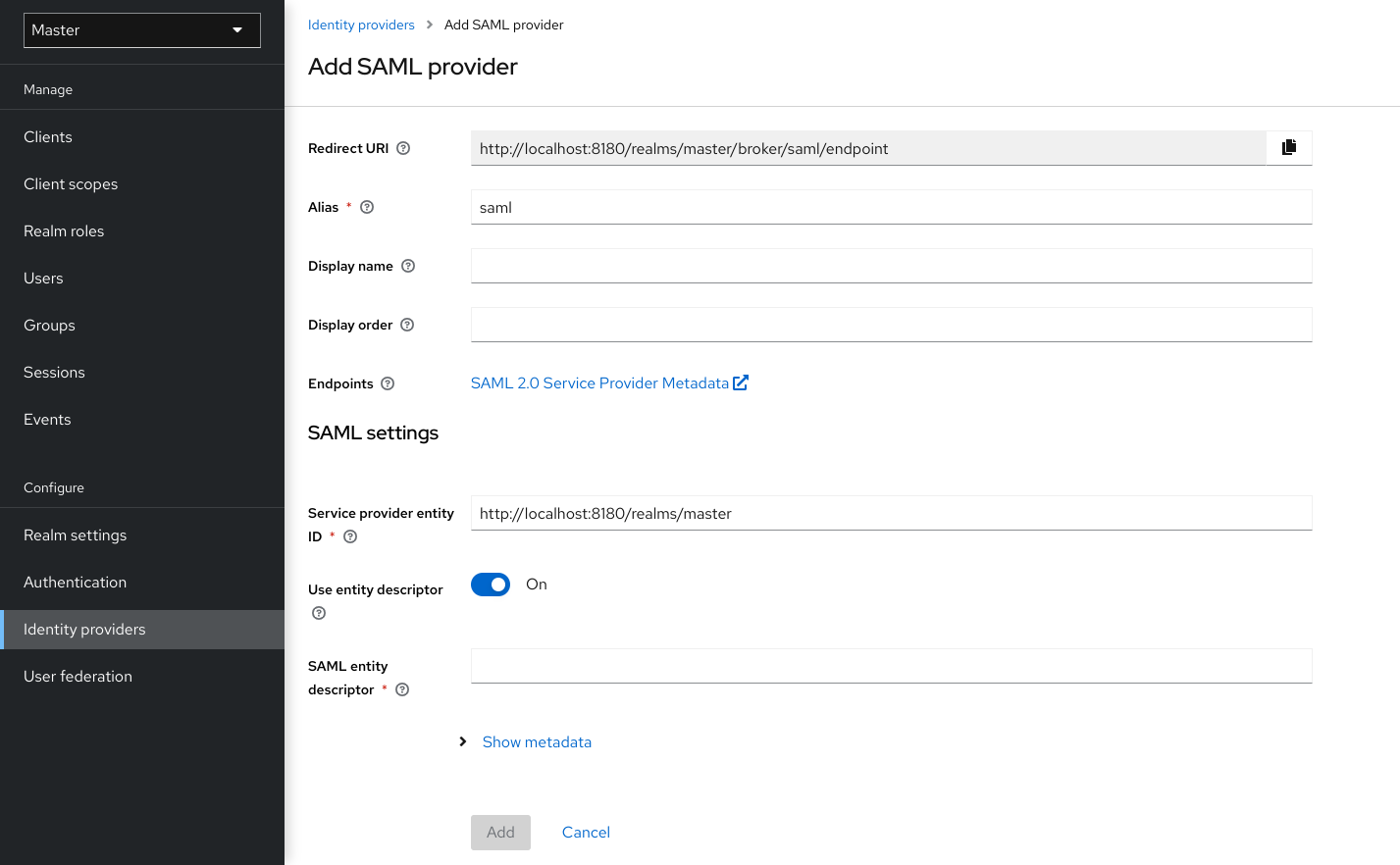SAML v2.0 Identity Providers
Keycloak can broker identity providers based on the SAML v2.0 protocol.
-
Click Identity Providers in the menu.
-
From the
Add providerlist, selectSAML v2.0.Add identity provider
-
Enter your initial configuration options. See General IDP Configuration for more information about configuration options. .SAML Config
| Configuration | Description |
|---|---|
Service Provider Entity ID |
The SAML Entity ID that the remote Identity Provider uses to identify requests from this Service Provider. By default, this setting is set to the realms base URL |
Single Sign-On Service URL |
The SAML endpoint that starts the authentication process. If your SAML IDP publishes an IDP entity descriptor, the value of this field is specified there. |
Single Logout Service URL |
The SAML logout endpoint. If your SAML IDP publishes an IDP entity descriptor, the value of this field is specified there. |
Backchannel Logout |
Toggle this switch to ON if your SAML IDP supports back channel logout. |
NameID Policy Format |
The URI reference corresponding to a name identifier format. By default, Keycloak sets it to |
Principal Type |
Specifies which part of the SAML assertion will be used to identify and track external user identities. Can be either Subject NameID or SAML attribute (either by name or by friendly name). Subject NameID value can not be set together with 'urn:oasis:names:tc:SAML:2.0:nameid-format:transient' NameID Policy Format value. |
Principal Attribute |
If a Principal type is non-blank, this field specifies the name ("Attribute [Name]") or the friendly name ("Attribute [Friendly Name]") of the identifying attribute. |
Allow create |
Allow the external identity provider to create a new identifier to represent the principal. |
HTTP-POST Binding Response |
Controls the SAML binding in response to any SAML requests sent by an external IDP. When OFF, Keycloak uses Redirect Binding. |
HTTP-POST Binding for AuthnRequest |
Controls the SAML binding when requesting authentication from an external IDP. When OFF, Keycloak uses Redirect Binding. |
Want AuthnRequests Signed |
When ON, Keycloak uses the realm’s keypair to sign requests sent to the external SAML IDP. |
Signature Algorithm |
If Want AuthnRequests Signed is ON, the signature algorithm to use. |
SAML Signature Key Name |
Signed SAML documents sent using POST binding contain the identification of signing key in |
Force Authentication |
The user must enter their credentials at the external IDP even when the user is already logged in. |
Validate Signature |
When ON, the realm expects SAML requests and responses from the external IDP to be digitally signed. |
Validating X509 Certificate |
The public certificate Keycloak uses to validate the signatures of SAML requests and responses from the external IDP. |
Sign Service Provider Metadata |
When ON, Keycloak uses the realm’s key pair to sign the SAML Service Provider Metadata descriptor. |
Pass subject |
Controls if Keycloak forwards a |
Attribute Consuming Service Index |
Identifies the attribute set to request to the remote IDP. Keycloak automatically adds the attributes mapped in the identity provider configuration to the autogenerated SP metadata document. |
Attribute Consuming Service Name |
A descriptive name for the set of attributes that are advertised in the autogenerated SP metadata document. |
You can import all configuration data by providing a URL or a file pointing to the SAML IDP entity descriptor of the external IDP. If you are connecting to a Keycloak external IDP, you can import the IDP settings from the URL <root>/realms/{realm-name}/protocol/saml/descriptor. This link is an XML document describing metadata about the IDP. You can also import all this configuration data by providing a URL or XML file pointing to the external SAML IDP’s entity descriptor to connect to.
Requesting specific AuthnContexts
Identity Providers facilitate clients specifying constraints on the authentication method verifying the user identity. For example, asking for MFA, Kerberos authentication, or security requirements. These constraints use particular AuthnContext criteria. A client can ask for one or more criteria and specify how the Identity Provider must match the requested AuthnContext, exactly, or by satisfying other equivalents.
You can list the criteria your Service Provider requires by adding ClassRefs or DeclRefs in the Requested AuthnContext Constraints section. Usually, you need to provide either ClassRefs or DeclRefs, so check with your Identity Provider documentation which values are supported. If no ClassRefs or DeclRefs are present, the Identity Provider does not enforce additional constraints.
| Configuration | Description |
|---|---|
Comparison |
The method the Identity Provider uses to evaluate the context requirements. The available values are |
AuthnContext ClassRefs |
The AuthnContext ClassRefs describing the required criteria. |
AuthnContext DeclRefs |
The AuthnContext DeclRefs describing the required criteria. |
SP Descriptor
When you access the provider’s SAML SP metadata, look for the Endpoints item in the identity provider configuration settings. It contains a SAML 2.0 Service Provider Metadata link which generates the SAML entity descriptor for the Service Provider. You can download the descriptor or copy its URL and then import it into the remote Identity Provider.
This metadata is also available publicly by going to the following URL:
http[s]://{host:port}/realms/{realm-name}/broker/{broker-alias}/endpoint/descriptorEnsure you save any configuration changes before accessing the descriptor.
Send subject in SAML requests
By default, a social button pointing to a SAML Identity Provider redirects the user to the following login URL:
http[s]://{host:port}/realms/${realm-name}/broker/{broker-alias}/loginAdding a query parameter named login_hint to this URL adds the parameter’s value to SAML request as a Subject attribute. If this query parameter is empty, Keycloak does not add a subject to the request.
Enable the "Pass subject" option to send the subject in SAML requests.